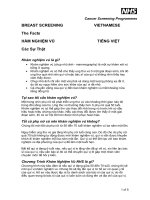Jusst the facts
Bạn đang xem bản rút gọn của tài liệu. Xem và tải ngay bản đầy đủ của tài liệu tại đây (4.54 MB, 406 trang )
Just the Facts!
Winning Endgame Knowledge
In One Volume
by
GM Lev Alburt
and GM Nikolay Krogius
Published by Chesswise.com
Originally Published by Chess Information and Research Center
© Copyright 2000. Lev Alburt and Nikolay Krogius
All rights reserved.
eISBN: 1-930936-17-6
This book is also available in print as ISBN: 1-889323-06-3.
Table of Contents
Just the Facts!
Winning Endgame Knowledge in One Volume
Chapter 1: What Is an Endgame?
Endgame knowledge—the key to chess mastery
The active king
Passed pawns
Zugzwang
Summary
Chapter 2: Pawn Endings
Part 1: King Position
King and one pawn versus king—the fundamentals
Chess is a game for squares
How to win a pawn up: Three rules for battling a blocking king
Most Winnable Endgames—the more pawns, the more winnable!
Rook pawns—when living on the edge can be safe
Defending by jailing the opposing king on the rook’s file
Safe squares
Passing the move (triangulation)
Calling in the reserves (reserve pawn moves)
The moving screen
The distant opposition
A classic triangulation
Part II: Passed Pawns
The advantage of the outside passed pawns
Mutual defense treaties between pawns
Creating passed pawns—radical breakthroughs
Summary
Learning Exercises
Chapter 3: Pawns against Pieces
Pawn versus knight
When the lone horseman holds off both king and rook pawn
You can’t always win
Bishop versus pawns
Rook against pawn
Cutting off the king on his third rank
The running screen in rook-versus-pawn endings
Two connected pawns versus the rook
Queen versus pawns
Summary
Learning Exercises
Chapter 4: Rook Endings
Rook and pawn versus rook, with the defending king blocking the pawn
Pawn is on the sixth rank
Pawn is not yet on the sixth rank—Philidor’s position
Lucena’s position
Counterattacking from the side—the long-side defense
When the long side is too short
The defending king is cut off from the pawn
When the extra pawn is a rook-pawn
Rook versus rook and two pawns
Special case of the rook- and bishop-pawns
Rook and pawns versus rook and pawns
Beware of passive defense
Summary
Learning Exercises
Chapter 5: Knight Endings
Knight and pawn against knight
The king takes part in the defense
Both sides have pawns, and one is passed
Wing majorities
Importance of the active king
Summary
Learning Exercises
Chapter 6: Bishop Endings
Part 1: Bishops of the Same Color
Pawn on the sixth or seventh rank
Pawn not yet on the sixth or seventh rank
Bishop and two pawns against bishop
Both sides have pawns—the “bad” bishop
Both sides have pawns—the “good” bishop
Same-Color Bishops: Drawing and Winning Methods
Other strategies
Part 2: Bishops of Opposite Color
Good fortresses require bad bishops!
Passed pawns
Don’t overburden your bishop
It’s not always a draw!
Fortress Building and Maintenance 101
Connected passed pawns—the three rules of defense
Targeting
Summary
Learning Exercises
Chapter 7: Knight against Bishop
Play with one pawn on the board
Play with multiple pawns
The knight can be the “Springer of surprises”!
The knight can be stronger in close quarters and closed positions
The knight against the bad bishop
Summary
Learning Exercises
Chapter 8: Queen Endings
Queen and pawn against queen
Queens and multiple pawns
Summary
Learning Exercises
Chapter 9: Mixed Bags
Basic checkmates
Bishop and knight
Two knights against a pawn
Focus on practicality
Rook versus knight with no pawns on the board
Don’t stand in the corner!
Rook versus knight with pawns on the board
Rook versus bishop
Rook and pawn versus bishop
Rook and pawns versus bishop and pawns
Rook and bishop versus rook
Queen versus rook
Queen versus rook and non-rook pawn
Queen versus rook and rook pawn
Queen versus rook and minor piece
Summary
Learning Exercises
Chapter 10: Multi-Piece Endings
Advantage of the bishop pair
Two rooks versus two rooks
The importance of a spatial advantage
Creating additional weaknesses
Summary
Learning Exercises
Chapter 11: Transitions
Playing for a favorable ending from move four
Heading for the endgame as a defensive measure
Summary
The Relative Value of the Pieces Change in the Endgame!
Learning Exercises
Conclusion
A Brief Endgame Glossary
Note to Reader
You should be able to read a chess book without squinting, without
forever flipping pages back and forth to find the relevant diagram, and
without trying to keep a 12-move variation in your head. We’ve tried to
produce Just the Facts! Winning Endgame Knowledge in One Volume in a
way that makes it enjoyable for you to get the most out of the unique
instruction it contains. Lots of diagrams make it easier. And look for
color-coded diagrams and “break-outs” that call your attention to the most
important positions and ideas. These will be especially worth revisiting
and even committing to memory.
A special note on notation and ranks
Just the Facts! uses the now universal algebraic notation. In the text,
however, when we discuss general rules—such as rooks belonging on
their seventh rank or the king being cut off on its fourth rank—we fall
back on the English descriptive tradition of relative perspective. This
technique is so widely used in both conversation and writing that it will
come naturally to readers, and it obviates the use of tedious and confusing
repetition (“The second rank for White, or the seventh for Black,” etc.).
For more on notation, see volume 1 of the Comprehensive Chess Course.
Introduction
“Just the facts, ma’am.”
—Detective Joe Friday of the popular 1950s Dragnet television series, to
countless crime witnesses tempted to stray from the essential points of the
case.
We’ve taken our cue from Jack Webb’s famous Dragnet detective. In a
hurry to solve a case, he wanted witnesses to give him quickly “Just the
facts.” We know that’s what you want when you sit down to spend your
precious free time to improve your chess.
Providing “just the facts” of all the endings you’re likely to encounter in a
lifetime of chess was a considerable challenge. It required the team of
famous player, writer, and teacher GM Lev Alburt and renowned endgame
expert and trainer GM Nikolay Krogius. Their decades of both
championship-level play and teaching on all levels, and their keen interest
in producing the most helpful material possible, led to a uniquely effective
approach.
The endgame is the last lap in the race for chess victory. In another sports
analogy, C.J.S Purdy called the ending the “putting” of chess. Joe Friday
might have said it was the perpetrator’s court conviction that served as the
epilogue of every episode of Dragnet. Whatever the metaphor, it’s clear
that, depending on your endgame knowledge, you can either enjoy the
victory your hours of concentration in the opening and middlegame have
earned you, or you can spoil it all. If you know some basic ideas and
techniques, you can even save some “lost” games. Such climaxes and anticlimaxes happen over and over in every chess tournament.
The best news is that your endgame play can improve dramatically in a
very short time—with the proper help. And a real knowledge of endgame
play will never go out of fashion. Here you have the essential ideas,
principles and positions. Just the Facts! will serve you well through many,
many years of chessboard battles.
Just the Facts! Winning Endgame Knowledge in One Volume is the final
volume of the Comprehensive Chess Course, a series that has earned a
special status with chess players. Each of its books has been a widely
praised best seller since first publication. That’s because each book is a
careful distillation and explanation of hundreds of years of master practice
and teaching.
The entire series focuses on making the most effective use of your time.
Only the important ideas are included. No sidetracks down theoretical
curiosities. No long, unexplained lines that leave you scratching your head
and looking at your watch. No asides that will lead you to a Jack Webb
staccato-like “Just the facts!” See page 412 of this book to order volumes
of the course.
After the hard work and high expectations, we’re very proud that the
seventh World Chess Champion, Vassily Smyslov, could write: “The right
endgame knowledge is the magic key to chess mastery. Just the Facts!
gives you that key!”
Al Lawrence, Executive Editor
Former Executive Director of the U.S. Chess Federation
Chapter 1: What Is an Endgame?
Some Important Ideas to Look For
Triumphant penetration of the king
White plays 6. Ka7.
See Diagram 2.
Power of the passed pawn
Black plays 1. ... Rxb2!.
See Diagram 12.
The winning power of zugzwang
White plays 1. Ke4!.
See Diagram 19.
The drawing power of zugzwang
White plays Ke6!.
See Diagram 21.
Chapter 1
What Is an Endgame?
Three Distinguishing Characteristics
You’d think that something so widely studied and discussed as the chess
endgame would be commonly well defined. Sometimes it’s described
simply as the final stage of a chess game. This definition isn’t accurate.
Many games finish before they ever reach an endgame—for example,
when a player resigns or is checkmated in the middlegame, or when he
blunders fatally in the opening. The exchange of queens is often heralded
as the onset of the endgame. But this is an oversimplification. There are
endgames with queens and there are middle games without them.
Perhaps it’s better to define the endgame simply as the stage of the game
with relatively few pieces on the board. Beyond this generalized
definition, there are three distinguishing characteristics that can help us to
both recognize the endgame and at the same time play better when we
reach one:
Endgames favor an aggressive king;
The importance of passed pawns is greatly increased in the endgame;
Zugzwang—the “compulsion to move” when doing so forces a player
into a worsened or even losing position—is often a factor in the
endgame while almost unheard of in the other stages.
In this chapter, we’ll take a look at each of these key characteristics in
turn.
ENDGAME KNOWLEDGE—THE KEY TO CHESS
MASTERY
Former World Champion Vassily Smyslov has called the endgame “the
magic key to chess mastery.” We hear and read constantly of new
subtleties in the opening said to confer an important advantage. The
unexpected combinations and sacrificial attacks of the middlegame excite
our fighting spirit and imagination. Why not just concentrate on these two
phases? Regretably, too many players fall into just that very trap. They
shortchange their endgame knowledge by spending all of their time for
chess on the first two parts of the game.
If you want to win at chess, begin with the ending.
—Irving Chernev
But any truly good player or coach will tell you that an approach that
ignores the endgame is both illogical and impractical. As we’ll see
throughout this book, many middlegame plans—and, occasionally even
opening strategies—have the goal of creating favorable endings. Without
practical endgame skill, you won’t be able to realize the opening or
middlegame advantage you fought so hard to achieve.
With knowledge of the basic endgame techniques, you can enjoy the
victory you’ve spent the whole game earning. At times, you’ll even be
able to pull yourself free of the steely jaws of “certain” defeat. And, as the
great world champion Jose Capablanca was fond of pointing out, no stage
of the game reveals the true powers of the pieces as does the endgame.
Those who study the endgame know the essence of chess.
OF THE THREE PHASES OF THE GAME—OPENING,
MIDDLEGAME AND ENDGAME, THE ENDGAME HAS THE
LEAST IN COMMON WITH ITS FELLOW STAGES IN TERMS
OF PRINCIPLES GUIDING CORRECT PLAY. IN FACT, SOME
RULES GOOD IN THE OPENING AND MIDDLEGAME
REVERSE THEMSELVES IN THE ENDGAME!
THE ACTIVE KING
To be a winning endgame general, you must know the key differences
between the ending and the other phases of the game, the opening and
middlegame. The critical distinction is that, in the endgame, the king often
becomes an active, even an aggressive piece. The sacred middlegame
commandment enjoining you to protect your king at all costs loses its
sanctity in the endgame, where the king attacks pawns and pieces and is
often first to penetrate the opponent’s position.
Let’s look at two examples that illustrate the active role of a king in
endings.
In Diagram 1, White’s chances are better because he has the two bishops
and an extra pawn on the queenside. Despite these advantages, after 1. ...
Nc4 2. Bc1 Rc7, Black could reasonably hope for a successful defense.
But the line Black chose in the game allowed the White king to penetrate
the queenside.
The king is a strong piece—use it!
—Reuben Fine
SVESHNIKOV—BROWNE
WIJK AN ZEE, 1981
Diagram 1
Black to move
Black should play 1. ... Nc4 2. Bc1 Rc7. You can learn from his mistake.
1. ... Nd3? 2. Rd1 Nc5+
Better was 2. ... Ne5. As often happens, one mistake begets another.
3. Kb4! Ne4
If 3. ... b6, then White plays 4. a4, with the threat of 5. a5.
4. Ka5 Nd6 5. Kb6 Rc6+ 6. Ka7
Diagram 2
A triumphal march of the king! Now Black can’t protect his pawns.
6. ... Rc7 7. Bb6 Rc6 8. Ba5 Be5 9. Bf3 Rc5 10. Bb4 Rc7
Diagram 3
11. Kb6!
White correctly delays capturing the pawn on b7.
11. ... Rd7 12. Re1 f6 13. a4 Kd8 14. Bxd6 Rxd6+ 15. Kxb7
Diagram 4
White has a passed c-pawn, and a potential passed pawn as its neighbor.
These guarantee White an easy win.
15. ... Rd2 16. Rd1 Rxd1 17. Bxd1 a5 18. Kb6 Bc7+ 19. Kc6
THE FIRST CRUCIAL DIFFERENCE BETWEEN THE
ENDGAME AND OTHER STAGES: ENDGAMES FAVOR AN
AGGRESSIVE KING!
Diagram 5
19. ... Bf4 20. Kb7 Be5 21. Be2 Bd6 22. g3 f5 23. Kc6 Bb8 24. Bc4 e5
25. b4
Diagram 6
25. ... Ba7 26. Kb7 Bxf2 27. bxa5 Bxg3 28. a6 Bf2 29. Be6
Diagram 7
Neutralizing Black’s passers.
29. ... f4 30. Bd5 h5 31. Bf3, Black resigns.
GRUND—UST
WEIMAR, 1968
Diagram 8
White to move
White’s king must penetrate Black’s position to attack the pawns at b6 and
h6. Black’s pawns and bishop block his way. But White can sacrifice to
create a path for his king.
1. b4! Bxb4
If 1. ... cxb4, then 2. Kb3 Bc1 3. Kxb4 Be3 4. Kb5 Ke7 5. Bd5 Bg1 6. a4
Bd4 7. c5! bxc5 (or 7. ... Bxc5 8. a5) 8. Bc4 and White will queen one of
his pawns.
Diagram 9
After 8. Bc4
2. Kb3 Ba5 3. Ka4 Ke7 4. Kb5 Kf6 5. Bd5 Ke7
Diagram 10
6. Kc6
Zugzwang.
6. ... Kf6 7. Kd7 Bc3 8. a4 Ba5 9. Ke8
Diagram 11
9. ... b5
Or else White plays 10. Kf8-g8-h7xh6. If 9. ... Kg7 then 10. Ke7.
10. axb5 Bc7 11. Kd7, Black resigns.
PASSED PAWNS
Passed pawns play an increasingly important role in the endgame, often
determining victory or defeat. In the middlegame, only a piece or two of
the many on the board may decide the outcome. But in the endgame, all
the pieces are likely to be engaged. and their activity sometimes centers on
forwarding or stopping a passed pawn.
ORTUETA—SANZ
MADRID, 1934
Diagram 12
Black to move
At first glance there is no serious threat to White’s position and the
outcome should most likely be a draw. But ...
1. ... Rxb2! 2. Nxb2 c3 3. Rxb6
Or 3. Nd3 c4 + 4. Rxb6 cxd3, and the Black pawns are unstoppable.
Diagram 13
3. ... c4!
Co-Author: International Grandmaster
Lev Alburt
Renowned player, teacher and writer
Place of Birth: Orenburg, Russia
Date of Birth: August 21, 1945
Mentored by world champion & pre-eminent teacher Mikhail Botvinnik
Three-time US Champion: 1984, 1985, 1990
Twice US Open Champion: 1987, 1989
Three-time Ukraine Champion: 1972-74
Popular Chess Life Columnist
Sought after teacher
Architect of best selling Comprehensive Chess Course
GM Alburt lived for many years in Odessa, a Ukrainian city located on the
Black Sea. He won the highly competitive Ukraine championship three









